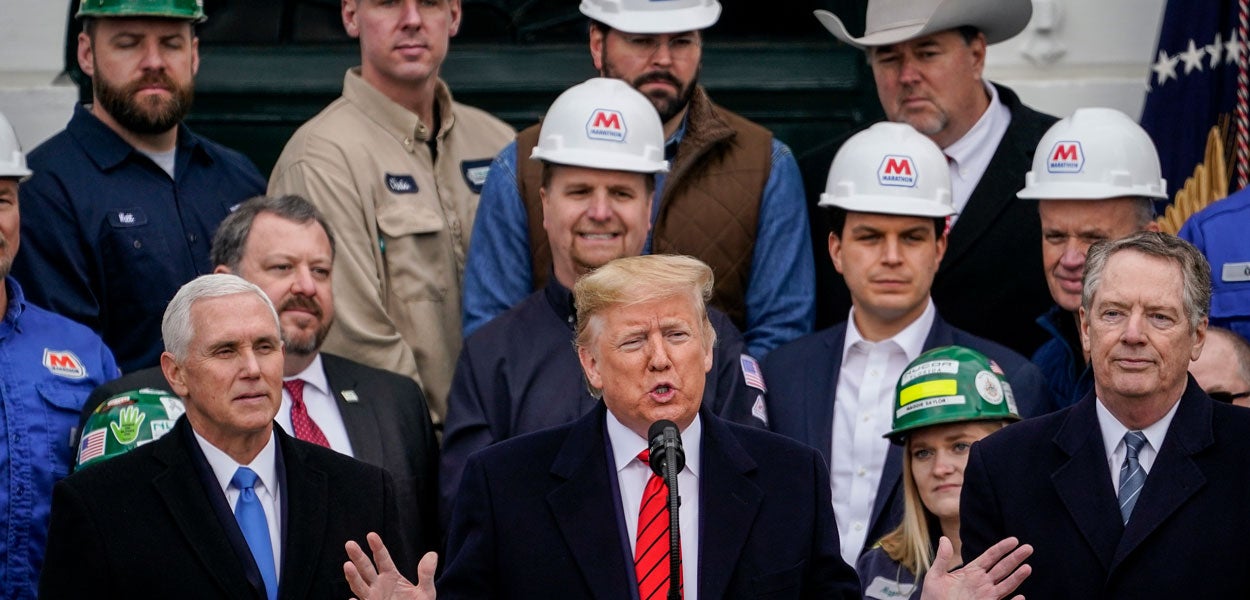Reflecting the current global economic slowdown, the latest statistics show that America’s trade with Canada and Mexico, the two largest trading partners of the U.S., has plummeted by more than 40% since last year.
According to the latest U.S. Census Bureau data, when compared with the previous April, U.S. trade with Canada and Mexico dropped by 43% and 46%, respectively.
Undoubtedly, the three North American trade partners—the United States, Mexico, and Canada—have been hard hit by the coronavirus pandemic in terms of both human and economic costs.
The Daily Signal depends on the support of readers like you. Donate now
>>> What’s the best way for America to reopen and return to business? The National Coronavirus Recovery Commission, a project of The Heritage Foundation, assembled America’s top thinkers to figure that out. So far, it has made more than 260 recommendations. Learn more here.
Although the U.S., Mexico, and Canada are on different timetables for their public health recoveries, it’s imperative that they not wait to begin planning for the region’s economic comeback.
One of the first practical steps in the reopening of North America’s economies will be the implementation of the United States-Mexico-Canada Agreement, currently scheduled to take effect on July 1.
The new trade agreement will provide the certainty and confidence so desperately needed by the private sectors of the three countries.
The pact, supported by a revived trilateral U.S.-Mexico-Canada governmental economic commission, will be the foundational business and institutional government-to-government framework on which post-pandemic North American economic partnerships can be constructed.
As pointed out by a recent Heritage Foundation report, the upcoming implementation of the trade pact will also help to reduce the region’s dependence on the People’s Republic of China by taking advantage of the global trend to de-Sinicize supply chains, which may also produce a shift of manufacturing jobs to North America.
The economic impact of the ongoing COVID-19 pandemic on the world and region has been far-reaching and hugely disruptive in terms of scale and velocity. It must not, however, be allowed to weaken or undermine the commitment to free trade or the implementation of the pact, which is at the very heart of the economic vitality of North America.
In the context of the pandemic recovery process, defending and advancing trade freedom is more critical than ever.
Uncertainty is the biggest threat to businesses of all sizes right now. In order to preserve the stability and predictability that result from the agreement, North American trade partners must adhere to the principles of economic freedom and implement the trilateral free-trade pact as scheduled. That’s the fastest path to a full economic reboot.
Additionally, policy priority should be given to proactive steps to advance e-commerce in the context of accelerating the implementation of the USMCA’s digital trade chapter, which provides a solid basis for further development of the already large cross-border flows of e-commerce.
Equally important is to ensure that the trade pact’s automotive rules of origin are implemented in a way that does not hinder the ability of the industry to start thriving again during and after the pandemic.
In this time of transition to the U.S.-Mexico-Canada Agreement, the uncertainty of the current situation should be minimized to maximize the utilization of supply chains in North America.
The recently released Heritage Foundation report “Saving Lives and Livelihoods: Recommendations for Recovery” by the National Coronavirus Recovery Commission underlined:
America must leverage its natural strengths of freedom and free enterprise to reinvigorate economic activity at home and abroad.
The U.S. should intentionally be proactive in promoting ‘free trade’ internationally.
Protectionist barriers should be reduced, with the caveats that trade should be economically fair over time, should protect intellectual property, and should be inherently safe.
The freedom to trade must be guarded and enhanced to spark constructive free-market competition and to ensure private sector growth for the economic recovery.
The timely and smooth implementation of the U.S.-Mexico-Canada Agreement is a critical step toward that.






























